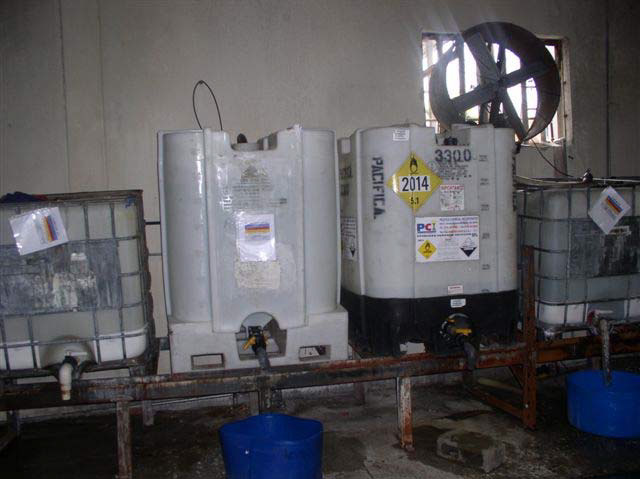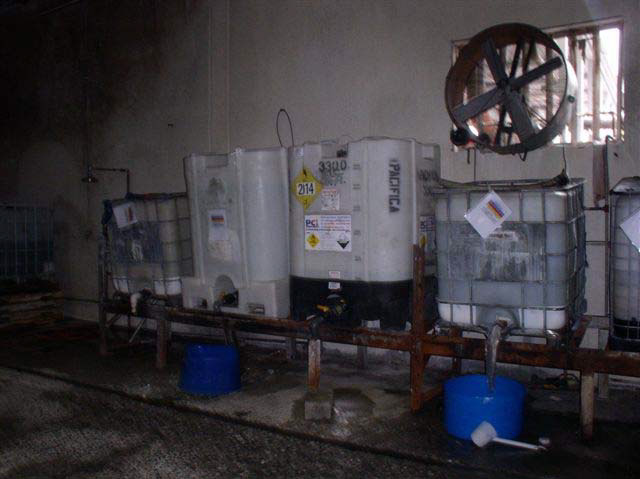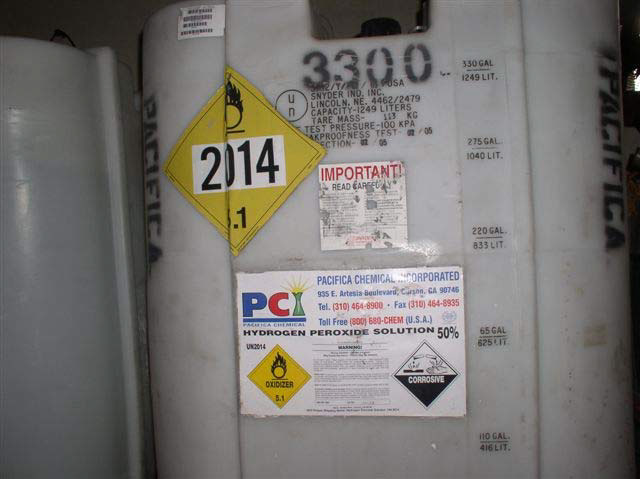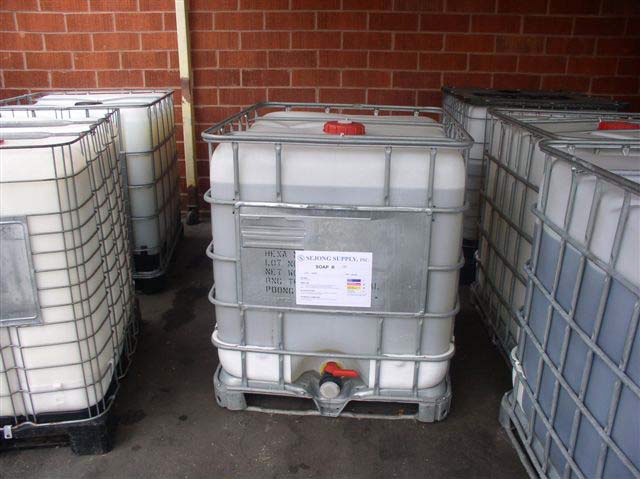Case Report: 09CA004
Chemist dies from burns caused by mixing chemicals
Download a PDF to print this report:
Chemist dies from burns caused by mixing chemicals (09CA004, PDF)
Summary
A 56-year-old chemist received fatal chemical burns from mist released after he mixed sodium hydroxide with hydrogen peroxide. The victim was refilling a container of hydrogen peroxide with the incorrect chemical (sodium hydroxide) using a non-standard transfer procedure. The victim was not wearing any form of personal protective equipment (PPE). The employer did not have a safety and training program to address hazardous chemical handling, storage, and use. The CA/FACE investigator determined that in order to prevent future incidents, employers who use hazardous chemicals in their work environment should ensure that:
- Specific safety and training programs are developed and implemented for the handling, storage, and use of hazardous chemicals.
Introduction
On Thursday May 28, 2009, at approximately 7:30 p.m., a 56-year-old chemist received chemical burns over 65% of his body when he mixed sodium hydroxide with hydrogen peroxide. He died from his injuries on June 4, 2009. The CA/FACE investigator was notified of this incident on June 8, 2009, from the Monrovia District Office of the Division of Occupational Safety and Health (Cal/OSHA). On June 10, 2009, the CA/FACE investigator inspected the incident site and interviewed the manager of the facility and a co-worker of the victim. On June 30, 2009, the CA/FACE investigator interviewed the safety consultant for the company. On July 10, 2009, the chemical supplier was interviewed and copies of the material safety data sheets (MSDS) were obtained for the chemicals involved in the incident. On August 12, 2009, a follow-up investigation was conducted at the incident site.
Employer
The employer of the victim was a textile dyeing and finishing company that specialized in fabrics made with spun yarn. The employer had been in business for five years and had 50 employees. There were 20 employees working at the time of the incident.
Written Safety Programs and Training
The employer had a general written Injury and Illness Prevention Program (IIPP) but did not have a safety and health training program in the storage, handing, and use of hazardous chemicals. There was no written evidence that the victim had received any safety training prior to or during his employment.
Worker Information
The victim was born in Korea and had been in the United States for 11 years. The victim had a bachelor's degree in chemistry. He spoke Korean, but did not speak English or Spanish. Company managers primarily spoke Korean, and most of the employees spoke Spanish. The victim had been employed with the textile company for five years and was the supervisor in charge of the chemical area. His responsibilities included maintaining the supply of chemicals and supervising employees working in the chemical measuring area. The prior work history of the victim was not available.
Incident Scene
The site of the incident was a chemical measuring area where storage containers up to 330 gallons held various chemicals used in the dye and finishing of fabrics.
Investigation
At 7:00 p.m. on the evening of the incident, the victim discovered that a container of hydrogen peroxide in the chemical measuring area was almost empty and had not been replaced before the start of his work shift. The victim went to the chemical storage area where he used a forklift to incorrectly pick up a 330 gallon container that contained sodium hydroxide. He drove the forklift into the chemical measuring area, and raised the container over the hydrogen peroxide container. The victim climbed on top of the hydrogen peroxide container and opened the spigot at the base of the sodium hydroxide container to drain the contents.
The mixture of sodium hydroxide and hydrogen peroxide immediately produced a thermal reaction with a release of a mist above the lid of the chemical container. According to a co-worker, the mist immediately engulfed the victim and filled the room. The victim jumped down from the container and ran toward a co-worker who washed down the victim with a hose. The local fire department and county hazardous material division responded after an emergency call was made by the plant office manager. The hazardous material team evacuated and ventilated the building. Employees were not allowed back in the building until the following day when atmospheric tests deemed it safe to enter. The victim was taken to a local hospital for emergency treatment and then transferred to a local burn center where he died on June 4, 2009.
Cause of Death
The cause of death according to the death certificate was sequelae of chemical burns from sodium hydroxide.
Recommendations / Discussion
Employers who use hazardous chemicals in their work environment should ensure that:
Recommendation # 1: Specific safety and training programs are developed and implemented for the handling, storage, and use of hazardous chemicals.
Discussion: In this incident, the victim selected the incorrect container of sodium hydroxide to replenish an empty hydrogen peroxide container. According to the employer’s controller, the victim had replaced containers of chemicals in the measuring area in the past without problems. The containers were labeled appropriately with the chemical names, which were probably visible to the victim and his co-workers. It is not known with certainty why the victim selected the incorrect container. The victim was not wearing any personal protective equipment (rubber boots, rubber apron or a rubber suit, rubber gloves, face shield, or approved respirator) that may have prevented dermal exposure and inhalation of the chemical. The mixture of sodium hydroxide and hydrogen peroxide produces a strong oxidizer called sodium peroxide and can result in an exothermic mist from the onset of high temperatures and heat from the decomposition of incompatible mixtures causing a severe thermal hazard. (2 NaOH + H2O2→Na2O2 + 2 H2O).
Whenever hazardous chemicals are used in a workplace and employees are exposed under normal conditions or can be expected to be exposed if an emergency arises, then employers should provide all employees with training on the appropriate means for storage, handling, and use. Employers should provide employees with current information and specific training on:
- Hazardous substances in their work area at the time of their initial assignment, and whenever a new hazard is introduced into their work area.
- Chemicals being used in their employment and as well as the location and availability of the written hazard communication program, including the list(s) of hazardous substances and material safety data sheets.
- Methods and observations that may be used to detect the presence or release of a hazardous substance in the work area.
- Physical and health hazards of the substances in the work area, and the measures they can take to protect themselves from these hazards, including specific procedures the employer has implemented to protect employees from exposure to hazardous substances, such as appropriate work practices, emergency procedures, and personal protective equipment to be used.
Had the victim received appropriate training on the handling and storage of chemicals, he may have taken steps to ensure that he did not refill the hydrogen peroxide container with the incorrect chemical. This could include a manual checklist to be completed during container replacement, barcode scan of container contents, or coworker sign-off of container contents. Had the victim taken one or more of these steps, this incident could have been prevented.
Exhibits

Exhibit 1. The chemical storage area where the incident occurred.

Exhibit 2. The incident scene.

Exhibit 3. The labeling on the hydrogen peroxide tank.

Exhibit 4. A chemical container (tote) similar to the one the victim had raised up on the forklift to transfer its contents.
References
Division of Occupational Safety and Health - Title 8 regulations - Subchapter 7. General Industry Safety Orders - Group 16. Control of Hazardous Substances - Article 109.
Hazardous Substances and Processes
§5162. Emergency Eyewash and Shower Equipment.
§5163. Spill and Overflow Control.
§5164. Storage of Hazardous Substances.
§5165. Dispensing Devices for Hazardous Substances.
§5167. Equipment and Processes Involving Hazardous Substances.
§5189. Process Safety Management of Acutely Hazardous Materials.
§5194. Hazard Communication.
MSDS Hydrogen Peroxide
MSDS Sodium Hydroxide
MSDS Sodium Peroxide
Authors
Hank Cierpich, FACE Investigator
Robert Harrison, MD, MPH, FACE Project Officer
Laura Styles, MPH, Research Scientist
January 11, 2010